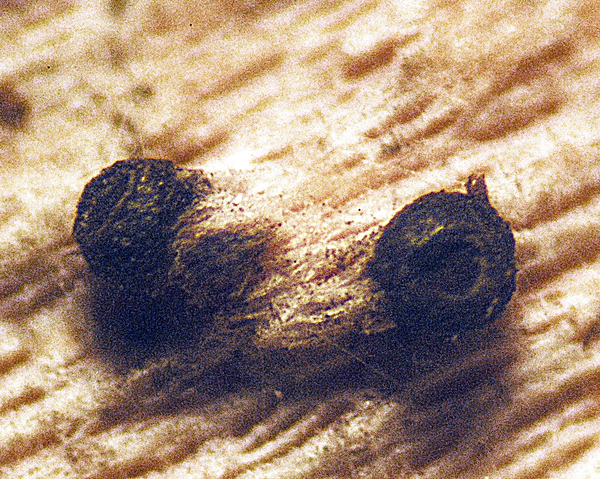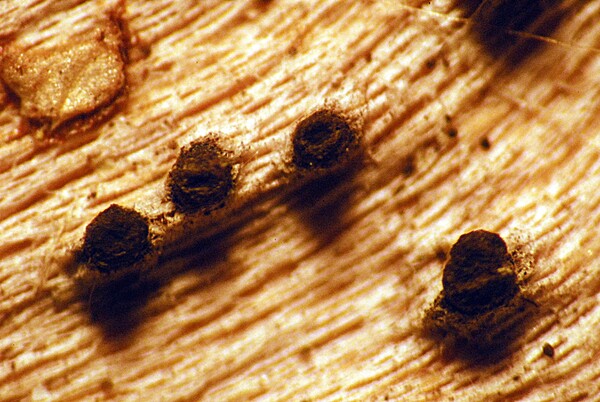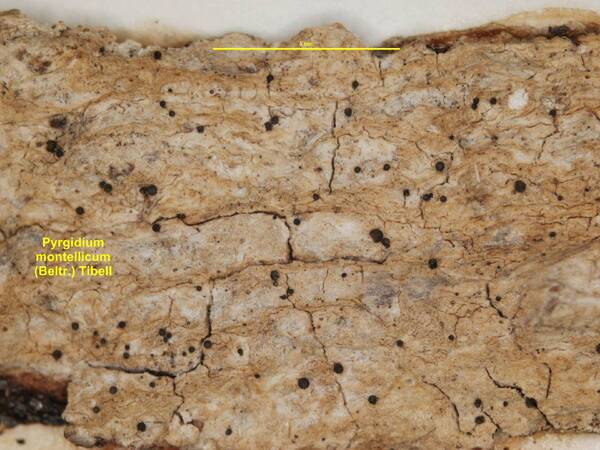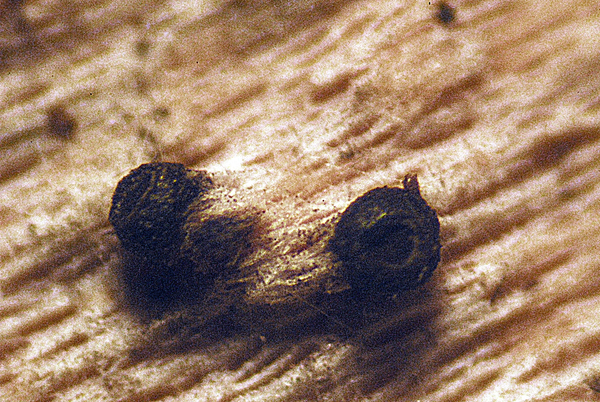Pyrgidium montellicum (Beltr.) Tibell
Lichenologist, 14: 239, 1982. Basionym: Acolium montellicum Beltr. - Lich. Bassan.: 285, 1858.
Synonyms:
Description: Thallus crustose, thinly episubstratic, continuous and farinose, whitish, very pale straw-yellow to yellowish grey, doubtfully lichenized. Apothecia sessile to shortly stalked, 0.13-0.29 mm high and 0.16-0.33 mm wide, almost spherical to ovoid, without a thalline margin. Mazaedium black, filling the apothecial cavity and more or less projecting above the excipular margin. Proper exciple prosoplectenchymatous, dark brown, (10-)22-32(-55) µm thick laterally, gradually attenuating towards the margin, (27-)40-80(-90) µm thick at base; paraphyses 0.4-2 µm thick, septate, unbranched. Asci 8-spored, cylindrical, unitunicate, short pedicellate, persisting almost until the spores have reached full maturity, blunt-tipped, not narrowing towards the apex, which is at first thickened, later reduced or inconspicuous, with uniseriately arranged spores. Ascospores 1-septate, pale to dark brown, broadly ellipsoid to oval, (4-)5.5-6.5(-10) x (2-)3-3.5(-5) µm, with a minute ornamentation of short, irregular, longitudinally arranged ridges. Photobiont absent (sometimes the thallus is loosely associated with mainly trentepohlioid algae). Spot tests: K-, C-, KC-, P-, UV-. Chemistry: without lichen substances.
Growth form: Fungus
Substrata: bark
Reproductive strategy: mainly sexual
Restricted to humid-warm, oceanic areas
Commonnes-rarity: (info)
Alpine belt: absent
Subalpine belt: absent
Montane belt: absent
Dry submediterranean belt: extremely rare
Humid submediterranean belt: extremely rare
Padanian area: absent
pH of the substrata:
1 2 3 4 5
Solar irradiation:
1 2 3 4 5
Aridity:
1 2 3 4 5
Eutrophication:
1 2 3 4 5
Poleotolerance:
0 1 2 3
Altitudinal distribution:
1 2 3 4 5 6
Rarity
absent
extremely rare
very rare
rare
rather rare
rather common
common
very common
extremely common
Loading data...
Occurrence data
Predictive map
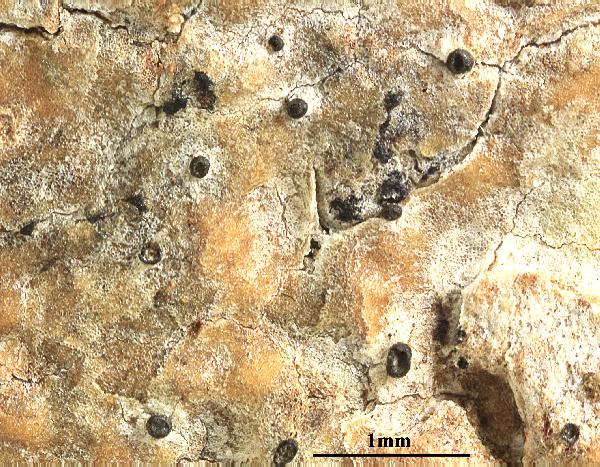
Felix Schumm - CC BY-SA 4.0
[ABL11449], Brazil, Rondônia, Porto Velho, Parque Circuito. 8°43'54''
S, 63°54'04'' W, 100 m. On Hevea brasiliensis bark in plantation. Leg.
M. Cáceres & A. Aptroot, (no. 11449), 11 March 1012, det. A. Aptroot
2012.
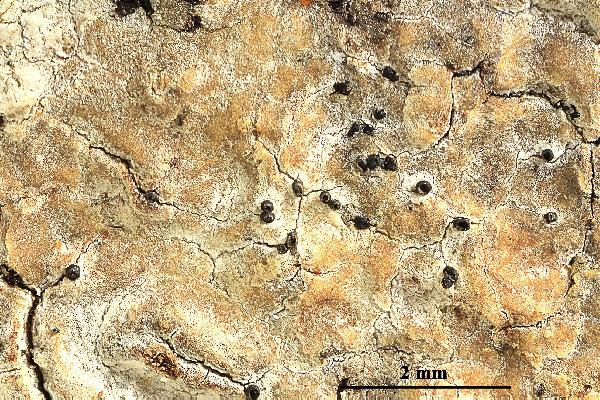
Felix Schumm - CC BY-SA 4.0
[ABL11449], Brazil, Rondônia, Porto Velho, Parque Circuito. 8°43'54''
S, 63°54'04'' W, 100 m. On Hevea brasiliensis bark in plantation. Leg.
M. Cáceres & A. Aptroot, (no. 11449), 11 March 1012, det. A. Aptroot
2012.
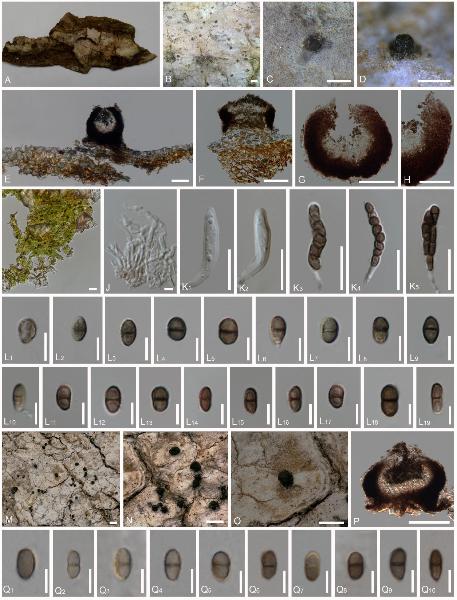
Source: Thiyagaraja, V.; Ertz, D.; Lücking, R.; Wanasinghe, D.N.; Aptroot, A.; Cáceres, M.E.d.S.; Hyde, K.D.; Tapingkae, W.; Cheewangkoon, R. Taxonomic and Phylogenetic Reassessment of Pyrgidium (Mycocaliciales) and Investigation of Ascospore Morphology. J. Fungi 2022, 8, 966. https://doi.org/10.3390/jof8090966 - CC BY 4.0
Pyrgidium montellicum (Thailand: MFLU 21-0135, Brazil: Cáceres and Aptroot 11449), (A–D). Ascomata on substrate (MFLU 21-0135), (E–G). Vertical section through the ascoma (MFLU 21-0135), (H). Vertical section through the exciple (MFLU 21-0135), (I). Loosely associated algae (MFLU 21-0135), (J). Paraphyses (MFLU 21-0135), (K1–K5). Asci (MFLU 21-0135), (L1–L10). Ascospores in water (MFLU 21-0135), (L11–L19). Ascospores in 5% KOH (MFLU 21-0135), (M–O). Ascomata on substrate (Cáceres & Aptroot 11449), (P). Vertical section through the ascoma (Cáceres and Aptroot 11449). (Q1–Q10). Ascospores in water (Cáceres and Aptroot 11449). Scale bars: (B–D), (M–O) = 500 μm, (C,D) = 200 μm, (E–G), (P) = 100 μm, (H) = 50 μm, (I) = 10 μm, (J) = 5 μm, (K1–K5) = 20 μm, (L1) = 10 μm, (L2–L19), (Q1–Q10) = 5 μm.
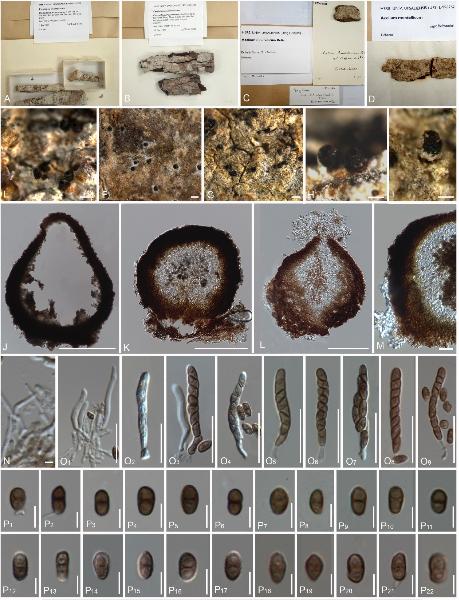
Source: Thiyagaraja, V.; Ertz, D.; Lücking, R.; Wanasinghe, D.N.; Aptroot, A.; Cáceres, M.E.d.S.; Hyde, K.D.; Tapingkae, W.; Cheewangkoon, R. Taxonomic and Phylogenetic Reassessment of Pyrgidium (Mycocaliciales) and Investigation of Ascospore Morphology. J. Fungi 2022, 8, 966. https://doi.org/10.3390/jof8090966 - CC BY 4.0
Pyrgidium montellicum (type materials of Acolium montellicum (L-008798, L-996762) and non-type materials of P. montellicum (Tibell 8306, Tibell 8232)), (A–D). Details of herbarium specimens (A). Tibell 8306, (B). Tibell 8232, (C). L-008798, (D). L-996762, (E–I). Ascomata on substrate (E,H). Tibell 8306, (F). Tibell 8232, (G,I). L-008798, (J–L). Vertical section through the exciple, (J). Tibell 8306, (K). Tibell 8232, (L). L-996762, (M). Tibell 8232, (N). L-996762, (O1–O9). Asci, (O1–O4,O7). L-996762, (O5,O6). L-008798, (O8,O9). Tibell 8232. Ascospores ((P1–P22), (P1–P6). Tibell 8306, (P7–P8). L-008798, (P12–P16). 1981 L-996762, (P17–P22). Tibell 8232)). Scale bars: (E,F) = 1000 μm, (G,H) = 500 μm, (J–L) = 100 μm, (M) = 20 μm, (K) = 5 μm, (O1–O9) = 20 μm, (P1–P22) = 5 μm.
Growth form: Fungus
Substrata: bark
Reproductive strategy: mainly sexual
Restricted to humid-warm, oceanic areas
Commonnes-rarity: (info)
Alpine belt: absent
Subalpine belt: absent
Montane belt: absent
Dry submediterranean belt: extremely rare
Humid submediterranean belt: extremely rare
Padanian area: absent
pH of the substrata:
| 1 | 2 | 3 | 4 | 5 |
Solar irradiation:
| 1 | 2 | 3 | 4 | 5 |
Aridity:
| 1 | 2 | 3 | 4 | 5 |
Eutrophication:
| 1 | 2 | 3 | 4 | 5 |
Poleotolerance:
| 0 | 1 | 2 | 3 |
Altitudinal distribution:
| 1 | 2 | 3 | 4 | 5 | 6 |
Rarity
absent
extremely rare
very rare
rare
rather rare
rather common
common
very common
extremely common
Loading data...
Occurrence data
Predictive map

Felix Schumm - CC BY-SA 4.0
[ABL11449], Brazil, Rondônia, Porto Velho, Parque Circuito. 8°43'54'' S, 63°54'04'' W, 100 m. On Hevea brasiliensis bark in plantation. Leg. M. Cáceres & A. Aptroot, (no. 11449), 11 March 1012, det. A. Aptroot 2012.

Felix Schumm - CC BY-SA 4.0
[ABL11449], Brazil, Rondônia, Porto Velho, Parque Circuito. 8°43'54'' S, 63°54'04'' W, 100 m. On Hevea brasiliensis bark in plantation. Leg. M. Cáceres & A. Aptroot, (no. 11449), 11 March 1012, det. A. Aptroot 2012.

Source: Thiyagaraja, V.; Ertz, D.; Lücking, R.; Wanasinghe, D.N.; Aptroot, A.; Cáceres, M.E.d.S.; Hyde, K.D.; Tapingkae, W.; Cheewangkoon, R. Taxonomic and Phylogenetic Reassessment of Pyrgidium (Mycocaliciales) and Investigation of Ascospore Morphology. J. Fungi 2022, 8, 966. https://doi.org/10.3390/jof8090966 - CC BY 4.0
Pyrgidium montellicum (Thailand: MFLU 21-0135, Brazil: Cáceres and Aptroot 11449), (A–D). Ascomata on substrate (MFLU 21-0135), (E–G). Vertical section through the ascoma (MFLU 21-0135), (H). Vertical section through the exciple (MFLU 21-0135), (I). Loosely associated algae (MFLU 21-0135), (J). Paraphyses (MFLU 21-0135), (K1–K5). Asci (MFLU 21-0135), (L1–L10). Ascospores in water (MFLU 21-0135), (L11–L19). Ascospores in 5% KOH (MFLU 21-0135), (M–O). Ascomata on substrate (Cáceres & Aptroot 11449), (P). Vertical section through the ascoma (Cáceres and Aptroot 11449). (Q1–Q10). Ascospores in water (Cáceres and Aptroot 11449). Scale bars: (B–D), (M–O) = 500 μm, (C,D) = 200 μm, (E–G), (P) = 100 μm, (H) = 50 μm, (I) = 10 μm, (J) = 5 μm, (K1–K5) = 20 μm, (L1) = 10 μm, (L2–L19), (Q1–Q10) = 5 μm.



